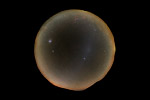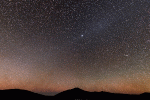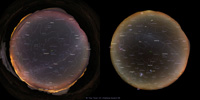HOME
The darkest sky ?
Milky Way all around the horizon line and Gegenschein.
© Stéphane Guisard, Los Cielos de América
I was wondering what conditions should be met to have the "darkest" sky ... Well, obviously there should be no Moon light. The Milky Way and Zodiacal light should not be visible neither , or kept to a minimum, and the image should be taken at a place with no light pollution. If these are correct criteriae, the following picture must be very close to what the "darkest" sky could be. The following image was taken close to new Moon (No Moon light), middle of the night (minimum zodiacal light effect), in the Atacama desert close to Paranal observatory (no light pollution). The chosen place for this picture has the particularity to be located at a latitude which value is close to the declination of the Southern Galactic Pole. The picture was therefore also taken when the galactic pole passes close to zenith, ensuring that there is no Milky Way up in the sky. When all these conditions are met, the very faint Gegenschein becomes visible. Like the zodiacal light, the gegenschein is sunlight reflected by interplanetary dust. Most of this dust is orbiting the Sun in about the ecliptic plane. The faint oval glow of Gegenschein can be seen in Pisces. The picture was taken after Local midnight 10th October 2010, It was a few weeks after Jupiter's opposition, so the bright planet lies just to the west of Gegenschein. The first image of this kind ever taken was made a few years ago here. The "by product" of this image is that the Milky Way plane lies all around the horizon as visible in this 360 degrees panoramic view.




The two galactic hemispheres
© Tunç Tezel and Stéphane Guisard
Upon the above publication of the Southern Galactic hemisphere, Tunç Tezel started seeking opportunities to create the Northern counterpart image. The left-hand side image was taken from Roque de los Muchachos (28d 45'S, 17d 53'W), in La Palma, Canary Islands. As the image was taken on 3rd May 2011, the oval glow of Gegenschein was lying in Libra. The only planet visible in the sky is Saturn in Virgo. It was about a month past Saturn's opposition, so the planet lies again to the west of Gegenschein. Just like Jupiter in the southern image.
Roque de los Muchachos is a quality dark sky location where many astronomical observatories reside, but there are still some sources of light pollution. So, this look away from the Milky Way to the galactic northern hemisphere is not perfectly dark. But still, the Milky Way is nearly lost, as it is again lying around the horizon.
So, the initial quest of having the darkest possible sky have delivered us these two all-sky images of the two galactic hemispheres as seen from Planet Earth.


Zoomable and 'full-screenable' fisheye view of the "darkest sky" Southern Galactic Hemisphere image. The Gegenschein is clearly visible covering most of the right side of the picture. The Large (LMC) and Small (SMC) Magellanic clouds are visible to the left, Orion constellation with Barnard loop to the top, California Nebula and 'tiny' Andromeda galaxy to the right while the Milky Way is visible all around the image on the horizon line. Bright jupiter is visible near the center of the image and bright red Eta Carina Nebula is rising on the horizon line at the very left (photo Stéphane Guisard).
Virtual reality tour of this panorama picture of the Southern Galactic Hemisphere. Click on the symbols in the window(GO FULLSCREEN BY CLICKING the arrowed 'X' on animation) or use arrow Keys or click & drag mouse to move Left/Right/Up/Down, Shift/Ctrl Keys or mouse wheel to zoom In/Out ....... have a nice trip !! (photo Stéphane Guisard).
360 degree Panorama of the Southern Galactic Hemisphere with Milky Way all around the horizon line (photo Stéphane Guisard).
Annotated 360 degree Panorama with Milky Way all around the horizon line (photo Stéphane Guisard).
The Northern Galactic Hemisphere (left, image by Tunç Tezel) and Southern Galactic Hemisphere (right, image by Stéphane Guisard).
Annotated version of the Northern Galactic Hemisphere (left, image by Tunç Tezel) and Southern Galactic Hemisphere (right, image by Stéphane Guisard).